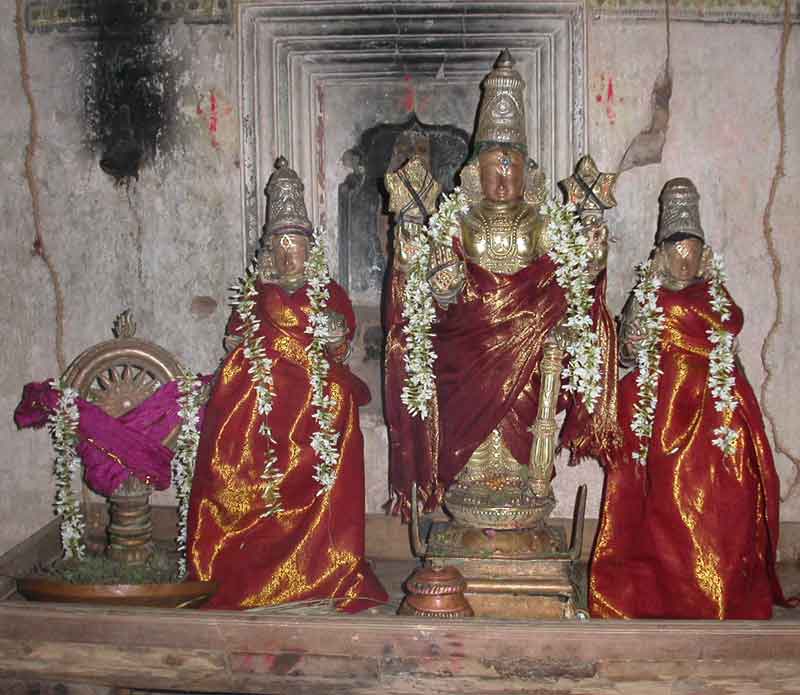GITA 10.40
We will see how the First Three Alwars worshipped Sri Trivikrama. This is a well-known story. Each Alwar was wandering in various places and singing in praise of the Lord. By a peculiar design of the Lord, the Three Alwars assembled in Tirukkovalur. They came to the same Ashram of sage Mrigandu. It was raining very heavily and Poigai Alwar entered the Ashram, for shelter. It was pitch dark inside. No one was inside the narrow place, and so thinking of the Lord, he laid down. After some time, Bhothathalwar came and knocked on the door to open. He was let in, but the space was sufficient for two to sit only. Next, Peyalwar came and knocked at the door to let him in. He also came inside and now all the three had to stand. All the Three were thinking of the Lord only, and the rain was still pouring outside. They were standing in the verandah [Tamil Idaikazhi இடைகழி, Sanskrit Dehali देहली ]. Suddenly they felt a Fourth Person was also occupying space and pressing them. They had not opened the door for anyone else. Then who could be that? Since it was dark, they thought they could find only with the help of light of a lamp. Poigai Alwar lighted a 'lamp'. He lighted a lamp with Earth as the container, oceans as the oil and bright Sun as the flame [வையம் தகளியாக, வார் கடலே நெய்யாக, வெய்ய கதிரோன் விளக்காக]. It formed the First pasuram of Mudhal Tiru Andhadhi [முதல் திரு அந்தாதி]. But that 'lamp' light was not enough to find the Fourth person. So, Bhoothathalwar lighted another 'lamp', with love as the container, enthusiasm as oil and his thoughts as the wick and lighted 'gyana deepam' [அன்பே தகளியா, ஆர்வமே நெய்யாக, இன்புருகு சிந்தை இடு திரியா, ஞானச் சுடர் விளக்கு ஏற்றினேன்]. This was the start of Irandam Tiru Andhadi [இரண்டாம் திரு அந்தாதி]. With this light now Peyalwar was able to 'see' Who was the Fourth Person. He saw Sri Maha Lakshmi. He saw the gold-hued Lord. He saw the Discus and Conch [திருக் கண்டேன், பொன் மேனி கண்டேன்...பொன்னாழி கண்டேன், புரி சங்கம் கண்டேன்]. This became the First hymn of Moonram Tiru Andhadi [மூன்றாம் திரு அந்தாதி]. All of them saw the Person, Who was pressing them in the same form as He is in this temple. So, in the garbha gruha, all the three Alwars are always present. What was seen by them First? Alwar says he saw Sri Nachiyar on the Chest of the Lord. This is the Unique identity for Sriman Narayana. Upanishads describe the Lord in a golden hue, with hair and moustache golden. These compilations of the Three Alwars form the First Three Prabhandams in Nalayira Divya Prabhandam. Therefore, we can say that Tirukkovalur is the nursery field for Nalayira Divya Prabhandam. Today's [ 22nd September 2008] is from Sri Nachiyar sannidhi.
 |
| SRI PUSHPAVALLI THAYAR |
In the sannidhi of Sri Trivikrama, Sri Maha Lakshmi is gracing; but here in the separate sannidhi, Sri Pushpavalli Thayar also known as Sri Poonkodhai Nachiyar [ஸ்ரீ பூங்கோதை நாச்சியார்] is gracing. Tirumangai Alwar has praised Sri Thayar here. Thus Four Alwars have praised the Lord here. We can note how much the Lord is eager to mingle with His devotees, setting aside all the discomforts, like narrow space. The Lord is also called Sri Dehalisan [ஸ்ரீ தேதஹளீசன் श्री देहलीस:]; dehali means verandah. It is another Sri Krishna Kshetram, besides Tirukkannapuram, Tirukkannangudi, Tirukkannamangai and Kapisthalam, forming Pancha Krishna Kshetrams. While going round the temple, we can also worship Sri Durga.
 |
| SRI DURGA |
We know the story of Sri Krishna's birth. In the jail of Mathura, Sri Krishna was born as the Eighth Son of Devaki, in Ashtami. About the same time, but in Navami, was born a female child to Yasoda in Gokulam. Vasudeva interchanged the Two, as ordered by Sri Krishna. After bringing the Female child to jail in Mathura, the child cried and Kamsa came to collect the Child. Though it was a female child, Kamsa tried to kill the infant by hitting against a rock. At that moment the child escaped and in the Yoga Maya form, chided and announced that Kamsa's enemy was growing in Gokulam. Thus, like a sister Sri Durga as Yoga Maya saved Sri Krishna and she is honoured in this temple, with a separate sannidhi. Sri Pushpavalli Nachiyar is showing protection by Her Right hand. In front of the sannidhi are Navarathri mandapam and Oonjal mandapam. In Panguni Utram festival, on the Seventh day, the Lord and the Sri Thayar grace together [சேர்த்தி]. The Lord also goes out for Fifteen days, in a festival for Theerthavari in the Ocean.
 |
| SRI AYANAR READY FOR HOLY BATH |
We can worship the Utsavar Sri Ayanar [ஸ்ரீ ஆயனார் ].The Lord Utsavar is adoring Gold armour [தங்கக் கவசம்].The Right hand is in Abhaya mudra, the Left arm is on the hip. No amount of description of His eminence could fully describe.
And, this is what the Lord says in the sloka 40:
nanto ’sti mama divyanam
vibhutinam parantapa
esa tuddesatah prokto
vibhuter vistaro maya
vibhutinam parantapa
esa tuddesatah prokto
vibhuter vistaro maya
"O mighty conqueror of enemies, there is no end to My divine manifestations. What I have spoken to you is but a mere indication of My infinite opulence."
(continued)











